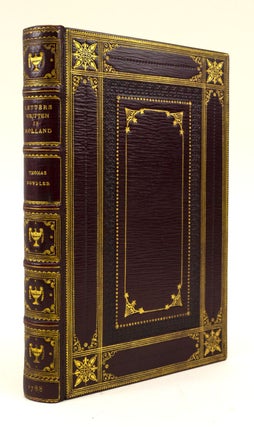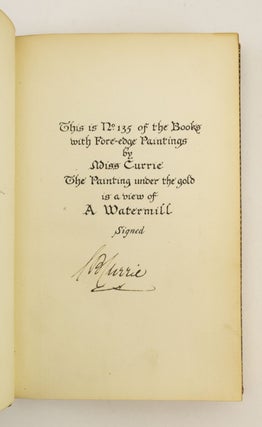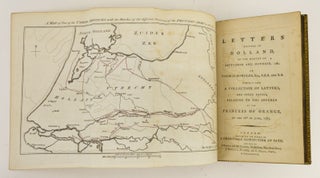LETTERS WRITTEN IN HOLLAND.
(London: Printed for the benefit of a Charitable Institution at Bath, and sold by J. Robson, W. Clarke, J. Debrett, and C. Dilly, 1788). 200 x 130 mm. (7 3/4 x 5"). 2 p.l., 192, 100 pp. FIRST EDITION.
ESPECIALLY PRETTY MAROON STRAIGHT-GRAIN MOROCCO BY RIVIERE & SON FOR HENRY SOTHERAN stamp-signed on front free endpaper), covers with alternating blind and gilt frames and floral cornerpieces, raised bands, spine compartments with gilt lettering or central goblet motif surrounded by multiple gilt rules, all edges gilt. WITH A CHARMING FORE-EDGE PAINTING BY MISS C. B. CURRIE depicting a lush country setting with a few cottages, one with a water mill, after a 1660 painting by Meindert Hobbema. With two engraved folding maps. A blank at front with a manuscript statement attesting that this is "No. 135 of the Books with Fore-edge Paintings by Miss Currie." ESTC T63080. ◆Corners a bit worn, leaves lightly browned, some infrequent and faint foxing, mild offsetting from maps, but still in excellent condition internally, being very clean and fresh; the decorative binding lustrous and scarcely worn, and the painting beautifully preserved.
This contemporary account of the 1787 Prussian invasion of Holland was handsomely bound for the bookseller Henry Sotheran and adorned with one of the few fore-edge paintings done by an identifiable artist--in the present case, a painter of considerable renown. Caroline Billin Currie is best known for her role in producing for Sotheran the so-called "Cosway bindings," which featured inset miniatures painted by her on ivory. Currie collaborated with Riviere on most of the Cosway bindings, which numbered about 1,000 by the time she died in 1940.
Her fore-edge paintings, by contrast, were far less numerous. According to Jeff Weber, she produced 172 known specimens, which, because of their scarcity and accomplished execution, are very much sought after. Called by Weber "a talented artist" whose works are "distinguished in more ways than one," Currie is the only fore-edge artist of any importance working before the present day whose creations are signed and numbered, as described above. She particularly enjoyed decorating older books like this one, and although the subjects of her paintings were often not relevant to the contents of the books they adorn, the image here certainly is. Her delicately rendered scene is based on a work by Dutch Golden Age painter Meindert Hobbema (1638-1709), a pupil of Jacob van Ruisdael; it shows a Holland far more tranquil than the country discussed in the text. Water mills were a favorite subject for Hobbema, and the view here includes a mill on a serene pond, with a cluster of neat cottages nearby.
In the text, the future censor of Shakespeare and Gibbon, Thomas Bowdler (1754-1825), records events that occurred during his 1787 visit to the Low Countries, when the Prussian army invaded to avenge the detention by anti-monarchist Dutch Patriots of the Princess of Orange, who happened to be the king of Prussia's sister. Bowdler is now remembered for producing "family-friendly" versions of Shakespeare's plays and Edward Gibbon's "Decline and Fall of the Roman Empire." His nephew noted that "'it was the peculiar happiness of the writer' to have so purified Shakespeare and Gibbon that they could no longer 'raise a blush on the cheek of modest innocence nor plant a pang in the heart of the devout Christian.'" (DNB). (ST16603)
Price: $7,500.00




